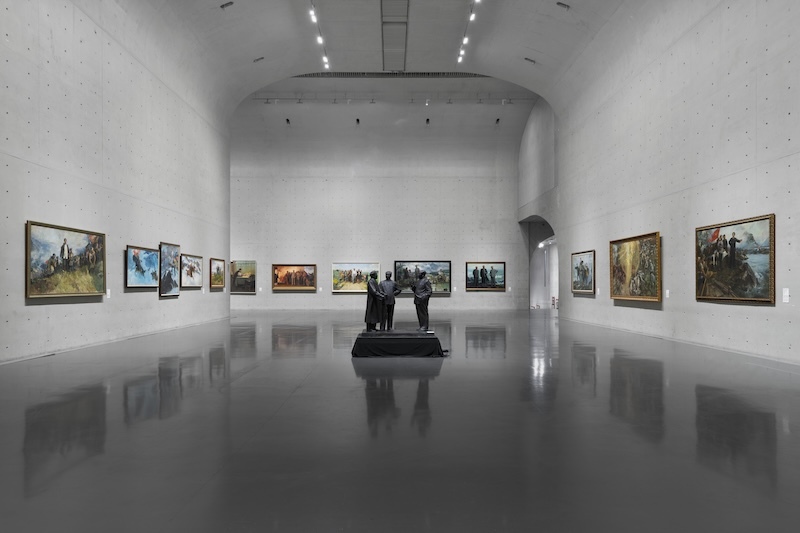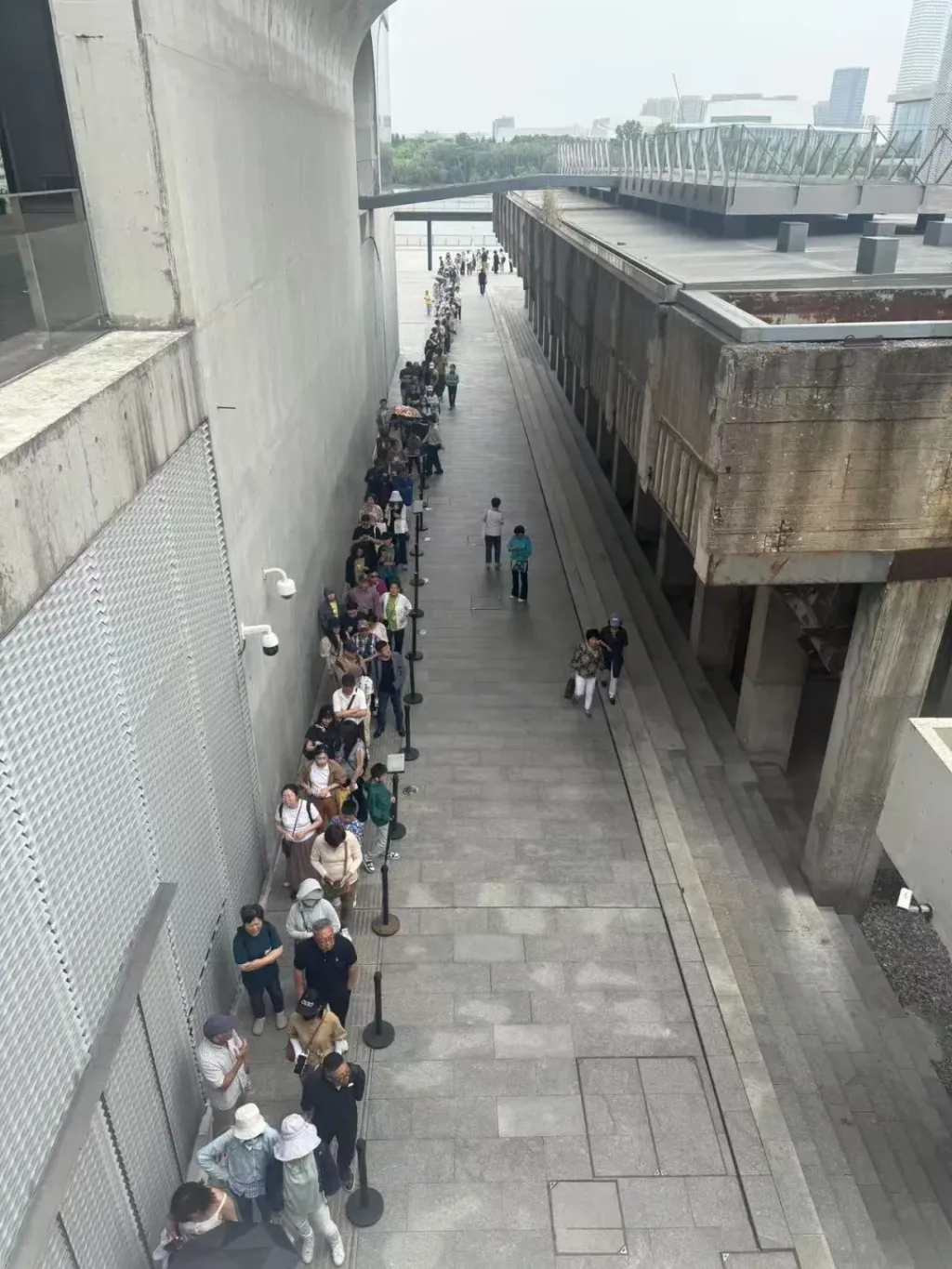
"We all come from this history, and it represents our history."
On July 12, the “Revolutionary Era: A Special Exhibition of New China-themed Art Creations” opened at the Long Museum (West Bund) in Shanghai. The exhibition presents more than 150 works created since the 1930s, covering a variety of media including oil paintings, Chinese paintings, prints, sculptures, propaganda posters, and New Year paintings, systematically combing through the image traditions and changes in the times of New China-themed art.

“The Era of Revolution: New China Theme Art Creation Special Exhibition” exhibition hall view, Long Museum (West Bund), Shanghai, Photo: Shaunley
After the previous exhibition "The Great View of Heaven and Earth: The Imprint of Civilization Across Time" came to an end, the iconic main exhibition hall of Long Museum (West Bund) was surrounded by art creations with the theme of New China. Time has also come from a thousand years ago to that fiery era.
As one of the most important collection systems of Long Museum, "New China Theme Art Creation" has been exhibited many times in different forms and combinations. The late art historian Chen Lusheng also sorted out this collection system and planned exhibitions many times.
This exhibition still bears traces of Chen Lusheng. It explores how thematic art has evolved along with the political and cultural progress of Chinese society, thus constituting an important part of China's visual culture in the 20th century, through three sections: "Leaders and Revolution", "Yan'an Spirit" and "Pace of the Times".

Exhibition Hall Scene
Talking about the collection of "New China Theme Art Creation", Wang Wei, director of Long Museum, said, "Since collecting the first piece of Zhang Hongxiang's "Hard Times" in 2003, we have collected nearly 300 works of this kind so far."
Due to historical reasons, many works were once scattered among the people, which provided her with an opportunity to systematically gather and study these works. "I think these artworks representing China's modern history should be collected by Chinese people. The reason why I have a special liking for works of this era and want to share with everyone the masterpieces of both artistic and historical value created during this special period is because we all came from this period of history, and it represents our history."

The opening ceremony, visitors visit
Woodcut and "Yan'an Spirit": Faith of the Times in Visual Language
The second section of the exhibition, "Yan'an Spirit", is based on prints and focuses on the "emerging woodcut movement" advocated by Mr. Lu Xun.
The works exhibited in this section start from the 1930s, showing the occurrence and development of the "new woodcut movement" in China, especially the role of printmaking creation in Yan'an and other revolutionary bases in the era before and after Mao Zedong's speech at the "Yan'an Forum on Literature and Art" in 1942. In 1929, Lu Xun and Rou Shi published the "Yiyuan Chaohua" series in the name of "Chaohua Society". Later, Lu Xun said in the introduction to "New Russian Painting Selection": "During the revolution, printmaking is the most widely used, even if it is extremely hasty, it can be done in an instant." By the summer of 1931, Shanghai had China's earliest woodcut workshop. Since then, woodcut has been in the ascendant in China, especially in the Anti-Japanese War.

The scene of the exhibition hall of "The Era of Revolution: Special Exhibition of Art Creation with the Theme of New China"
The exhibition displays works by the first generation of emerging woodcut printmakers trained by Lu Xun, such as Chen Yanqiao and Li Hua, as well as the second generation influenced by Lu Xun, such as Yang Keyang and Zhao Yannian.

The exhibition site, works by Chen Yanqiao and Zheng Yefu (right)
In the exhibition, "Mr. Lu Xun" is Zhao Yannian's representative woodcut work, and also a masterpiece that shaped the image of Lu Xun after the founding of New China. In 1961, when it was the 80th anniversary of Lu Xun's birth, Shanghai People's Fine Arts Publishing House planned to issue a propaganda poster. Yang Keyang commissioned Zhao Yannian, who was working in Hangzhou, to participate in the creation of Lu Xun's portrait, thus giving birth to this classic work of Lu Xun's portrait. The picture uses concise, rough and powerful knife techniques, and a black and white contrasting composition to create an image of Lu Xun wearing a scarf in the cold wind, looking coldly ahead, and moving forward against the wind. The picture has a shocking impact.

Exhibition site, works by Zhao Yannian (left)
The exhibits include early works depicting scenes of the War of Resistance Against Japanese Aggression and life in Yan'an, as well as prints from the 1950s onwards with diverse themes and techniques. From grand narratives to street life, these works reflect how prints from the new China strike a balance between social service and artistic expression.

The scene of the exhibition hall of "The Era of Revolution: Special Exhibition of Art Creation with the Theme of New China"
Revisiting the national image through artists' works
In 2018, Long Museum held a special exhibition for a painting, "Standing Guard for Our Great Motherland," believing that it "witnessed an era."

Exhibition site, Shen Jiawei's "Standing Guard for Our Great Motherland"
In this exhibition, Shen Jiawei's "Standing Guard for Our Great Motherland" is on display again. This oil painting reflecting Sino-Soviet relations became famous at the National Art Exhibition in 1974, becoming one of the iconic works of art in the 1960s and 1970s, and was collected by the National Art Museum of China. However, the work returned to the artist in 1982, and then was put under the bed for 15 years. It was restored by the artist in 1997, and then the painting was passed around for several times, and became the collection of the Long Museum in 2009.

At the exhibition, Jin Shangyi and Fu Zhigui collaborated on the work "Dedicating the First Seamless Steel Pipe to Chairman Mao"
Let’s look at the collaborative work by Jin Shangyi and Fu Zhigui, “Presenting the First Seamless Steel Pipe to Chairman Mao” (1954), Sun Zixi’s “In Front of Tiananmen Square” (1968-1974), Yan Zhenduo’s “Wang Tieren” (1973), etc. These works are not only the results of artistic creation, but also an integral part of the national narrative.

Sun Zixi, “In Front of Tiananmen Square”, 1968-1974
Typical cases such as "Standing Guard for Our Great Motherland" trace back the system and visual logic of "theme creation" in the mid-to-late 20th century. These works are not only the results of artistic creation, but also an integral part of the national narrative. They show how artists in New China respond to the propositions of the times, and also reflect how art serves national goals under a specific system.

Exhibition View
As Chen Lusheng wrote in the conclusion of the exhibition: "These themes either reflect history or express reality. The pursuit of realism or romanticism expressed in their thoughts all confirm that passionate era. In that era, the theme creation was closely integrated with the social reality requirements of each period, not only praising the revolutionary history, but also participating in social reality. However, due to real political reasons, the ill-fated theme creation has also become a special phenomenon in art creation since the mid-20th century."
The exhibition will run until November 2

Exhibition Conclusion
Visiting Tips:
No reservation is required for the Long Museum (West Bund). Tickets must be purchased at the museum's service desk (200 yuan per person). Junior high school and elementary school students can visit all exhibitions of the Long Museum (West Bund) for free by showing their student ID cards. The first Tuesday of every month is the Long Museum's free opening day (except holidays and special exhibitions).
- LureQYlR07/13/2025
- PdKGKlZUSbY07/13/2025
- SbtjJsFE07/13/2025


